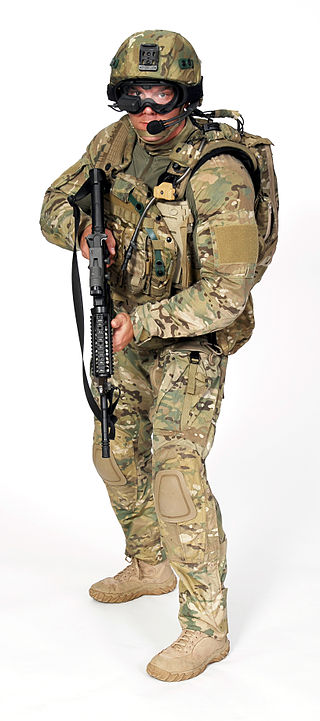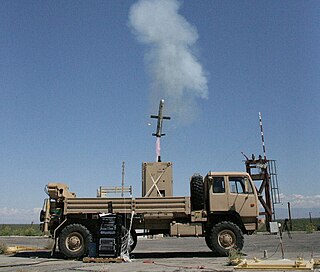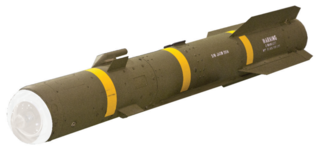
The Defense Advanced Research Projects Agency (DARPA) is a research and development agency of the United States Department of Defense responsible for the development of emerging technologies for use by the military.

The MIM-104 Patriot is a surface-to-air missile (SAM) system, the primary such system used by the United States Army and several allied states. It is manufactured by the U.S. defense contractor Raytheon and derives its name from the radar component of the weapon system. The AN/MPQ-53 at the heart of the system is known as the "Phased Array Tracking Radar to Intercept on Target," which is a backronym for "Patriot". In 1984, the Patriot system began to replace the Nike Hercules system as the U.S. Army's primary high to medium air defense (HIMAD) system and the MIM-23 Hawk system as the U.S. Army's medium tactical air defense system. In addition to these roles, Patriot has been given a function in the U.S. Army's anti-ballistic missile (ABM) system. The system is expected to stay fielded until at least 2040.

Paveway is a series of laser-guided bombs (LGBs).

The Berkeley Lower Extremity Exoskeleton (BLEEX) is a robotic device that attaches to the lower body. Its purpose is to complement the user's strength by adding extra force to the user's lower extremity bodily movements. The BLEEX was funded by the Defense Advanced Research Projects Agency (DARPA), and developed by the Berkeley Robotics and Human Engineering Laboratory, a unit within the University of California, Berkeley Department of Mechanical Engineering. DARPA provided the initial $50 million of start-up funds in 2001.
The Combat Capabilities Development Command Soldier Center, formerly the United States Army Natick Soldier Research, Development and Engineering Center, is a military research complex and installation in Natick, Massachusetts, charged by the U.S. Department of Defense with the research and development of food, clothing, shelters, airdrop systems, and other servicemember support items for the U.S. military. It is a component unit of the United States Army Combat Capabilities Development Command and is a tenant unit of the United States Army Natick Soldier Systems Center (SSC). The installation includes facilities from all the military services, not just the Army, and is so configured to allow cross-service cooperation and collaboration both within the facility and with the many academic, industrial and governmental institutions in the Greater Boston Area.

The M270 Multiple Launch Rocket System is an American-developed armored, self-propelled, multiple rocket launcher.

Terminal High Altitude Area Defense (THAAD), formerly Theater High Altitude Area Defense, is an American anti-ballistic missile defense system designed to shoot down short, medium, and intermediate-range ballistic missiles in their terminal phase by intercepting with a hit-to-kill approach. THAAD was developed after the experience of Iraq's Scud missile attacks during the Gulf War in 1991. The THAAD interceptor carries no warhead, instead relying on its kinetic energy of impact to destroy the incoming missile.
The Medium Extended Air Defense System (MEADS) is a ground-mobile air and missile defense system intended to replace the Patriot missile system through a NATO-managed development. The program is a development of the United States, Germany and Italy.

Future Force Warrior was a United States military advanced technology demonstration project that was part of the Future Combat Systems project. The FFW project sought to create a lightweight, fully integrated infantryman combat system. It was one technology demonstration project in a series of network-centric, next-generation infantry combat projects the U.S. military have developed over the past decade, such as the Soldier Integrated Protective Ensemble technology demonstration program, Land Warrior, and Transformation of the United States Army.

The Non-Line of Sight Launch System (NLOS-LS) was a self-contained missile launcher system that was under development by NETFIRES LLC, a partnership between Lockheed Martin and Raytheon. Each Container Launch Unit (CLU) holds 15 missiles, and a self-locating networked communications system. CLUs can be linked for coordinated launching, with the missiles fired and controlled remotely via autonomous vertical launch. The weapon is roughly 2 metres tall.

The AGM-179 Joint Air-to-Ground Missile (JAGM) is an American military program to develop an air-to-surface missile to replace the current air-launched BGM-71 TOW, AGM-114 Hellfire, and AGM-65 Maverick missiles. The U.S. Army, Navy, and Marine Corps plan to buy thousands of JAGMs.
Squad Mission Support System is an unmanned all terrain wheeled vehicle developed by Lockheed Martin.

SoldierStrong is a Stamford, Connecticut based 501(c)(3) charitable organization whose mission is to improve the lives of the men and the women of the United States Armed Forces.

A powered exoskeleton is a mobile machine that is wearable over all or part of the human body, providing ergonomic structural support and powered by a system of electric motors, pneumatics, levers, hydraulics or a combination of cybernetic technologies, while allowing for sufficient limb movement with increased strength and endurance. The exoskeleton is designed to provide better mechanical load tolerance, and its control system aims to sense and synchronize with the user's intended motion and relay the signal to motors which manage the gears. The exoskeleton also protects the user's shoulder, waist, back and thigh against overload, and stabilizes movements when lifting and holding heavy items.
Homayoon Kazerooni is an Iranian-born American roboticist, mechanical engineering, and professor. He serves as a professor of mechanical engineering, and the director of the Berkeley Robotics and Human Engineering Laboratory at the University of California, Berkeley. Kazerooni is also the co-founder of Ekso Bionics and SuitX. As a noted authority on robotics, he is frequently profiled and quoted in the media.

Ekso Bionics Holdings Inc. is a company that develops and manufactures powered exoskeleton bionic devices that can be strapped on as wearable robots to enhance the strength, mobility, and endurance of industrial workers and people experiencing paralysis and mobility issues after a brain injury, stroke, multiple sclerosis (MS) or spinal cord injury. They enable individuals with any amount of lower extremity weakness, including those who are paralyzed, to stand up and walk.
Berkeley Robotics and Human Engineering Laboratory is managed and operated by University of California, Berkeley. The lab conducts scientific research on the design and control of a class of robotic systems worn or operated by humans to increase human mechanical strength.
Neuromechanics of orthoses refers to how the human body interacts with orthoses. Millions of people in the U.S. suffer from stroke, multiple sclerosis, postpolio, spinal cord injuries, or various other ailments that benefit from the use of orthoses. Insofar as active orthoses and powered exoskeletons are concerned, the technology to build these devices is improving rapidly, but little research has been done on the human side of these human-machine interfaces.

The Oshkosh L-ATV is a light utility/combat multi-role vehicle that won the US military's Army-led Joint Light Tactical Vehicle (JLTV) program. In the very early stages of the program it was suggested that JLTV would replace the AM General High Mobility Multi-purpose Wheeled Vehicle (HMMWV) on a one-for-one basis. It is now suggested that the JLTV will partly replace the HMMWV, not replace it on a like-for-like basis.
The FireFly Acoustic Threat Detection System is a system for detecting hostile fire. It has been developed jointly by the US Army Aviation and Missile Research Development and Engineering Command (AMRDEC), the U.S. Army Research Laboratory (ARL) and industry partners. The FireFly acoustic and electro-optical (EO) sensor can operate with Serenity Payload or be deployed as a stand-alone unit. FireFly was designed for support of small installations, independent of installation power.













